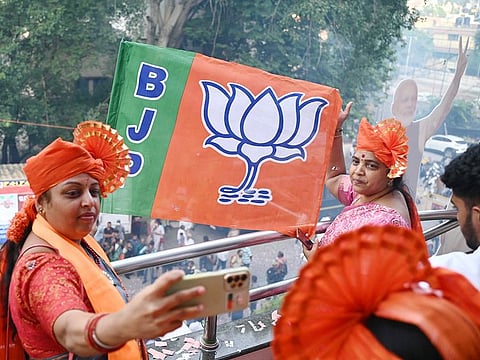Why the BJP campaign that started with a bang ended in a whimper
BJP made a series of mistakes out of overconfidence, losing seats they should have won

This writer, like many others, failed to see the Bharatiya Janata Party’s stunning underperformance in the 2024 Lok Sabha elections. With that necessary mea culpa, we must exploit the benefit of hindsight and understand why the BJP couldn’t even touch the majority mark.
In one word, what was the BJP’s main narrative pitch in the election? In 2014 it was Development (“Acche Din”). In 2019 it was National Security (“Main Bhi Chowkidar”). In 2024? Nothing. Nada.
We heard the phrase “Modi ki guarantee” but we weren’t told what exactly he’s guaranteeing. The manifesto didn’t have a single thing that came through as new, striking or original.
Power over people
The main slogan — “Abki Baar 400 paar” (This time over 400 seats) was a bad one for multiple reasons. It suggested the BJP’s focus was power, not the people’s welfare. Some Dalits felt the BJP wanted 3/4ths majority to amend the Constitution and end reservations for them. The slogan also made the BJP’s own support base complacent about a victory.
The impression that the BJP was now interested only in consolidating its own power was buttressed by prosecution against many opposition leaders.
Undermining mass leaders
If you travelled this election you heard people everywhere complain about poor BJP candidates. This was especially the case in Uttar Pradesh. It can’t be that a party like BJP, with myriad surveys at its disposal, didn’t know who’d be the best possible candidate for every seat. BJP cadres, RSS activists and the party’s supporters felt the party was deliberately sidelining mass leaders.
Take for example how Menaka Gandhi was made to contest not from her traditional seat of Pilibhit but from Sultanpur. The clear suggestion is that the party didn’t want leaders winning in their own name. If they could win in the name of the party or PM Modi, they were welcome. After Shivraj Singh Chouhan was not made the Madhya Pradesh chief minister, supporters of CM Yogi Adityanath felt it was his turn next to be removed.
This writer personally met BJP workers in east UP who were doing “bheetar ghaat” or sabotage, campaigning not to make the BJP win but to make the BJP lose. The quiet, last-minute sabotage by BJP workers is possibly one reason why we couldn’t see the scale of the BJP’s decline this election in UP and other states.
The BJP’s poor candidate selection was juxtaposed by the excellent candidate selection of the opposition parties, at least in UP. The Samajwadi Party in particular managed to strike a chord with lower OBC and even Dalit voters with its candidate selection.
Taking Brand Modi for granted
The BJP has held its ground at least in number of seats in Central India. The BJP’s sharp fall in seats and vote share in West Bengal, Uttar Pradesh, Rajasthan and Haryana is proof that there wasn’t a uniform Modi wave across the Hindi heartland as was the case in 2014 and 2019.
PM Modi is still immensely popular, but not popular enough to enjoy a lamp post election. People felt they deserved better than lamp posts as their representatives in Parliament. Caste, community, and economic issues could no longer be brushed under the carpet.
No new welfare schemes
The Modi government gave free ration to 80 crore people but it was already heavily subsidised. It saved only around Rs500 a month per family. After the Covid-induced economic distress, people expected some relief from the government.
As compared to Modi-1, there was very little. In fact, there was not a single new welfare scheme that was launched. Even the pre-election interim budget had nothing for the masses.
PM Modi proudly said in an interview that he was winning this election without freebies. In the absence of mass job creation, people felt some band-aid was necessary. The election results show the BJP has suffered its losses mostly in rural and semirural areas.
Pretending unemployment is not an issue
Educated unemployed youth — the sort who spend years preparing for competitive exams for government jobs — may be small in number. But they voted for the BJP in 2019 with the faith that jobs are coming.
The BJP pretended unemployment is not an issue and did not address their concerns. They actively went around persuading people to not vote for the BJP in many places. This was not even an effort mobilised by the opposition.
Delayed and prolonged election
The inauguration of the Ram Mandir in January was supposed to tick the Hindutva box in campaign. But it was already old news by the time the elections began in April. The G20 summit in Delhi in September last year, meant to drum up nationalist sentiment, felt like prehistory.
Delayed and prolonged elections, the BJP thought, would give it time to maximise Modi rallies and media exposure. Instead it backfired, as the BJP’s own supporters and cadres found it difficult to drum up street enthusiasm in heat.
Index of opposition unity
In the Varanasi Lok Sabha seat, PM Modi’s own votes came down from 64% in 2019 to 54% of total votes cast. The runner up’s votes increased from 18% in 2019 to 40% in 2024. In other words, more than the decline in the BJP’s votes, it is the consolidation of opposition votes that made the difference. This is how PM Modi’s margin of victory came down from 4.79 lakh votes to a mere 1.5 lakh votes.
The Varanasi example is seen across the state. The SP-Congress alliance in UP helped voters ignore the BSP. In UP and in other states to a lesser extent, the high index of opposition unity gave the BJP a run for its money. The INDIA alliance worked well in many places.
Sign up for the Daily Briefing
Get the latest news and updates straight to your inbox




